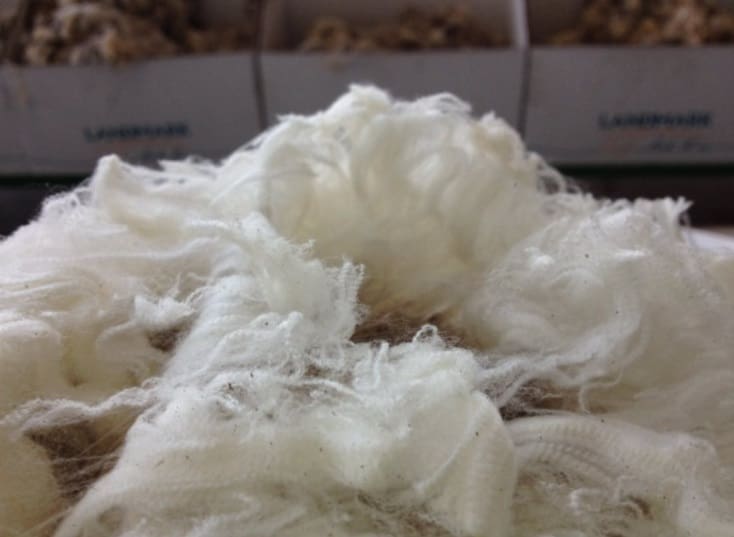
Wool in a sale sample. Picture – AWEX.
FAVOURABLE exchange rates and further evidence of declining forward greasy wool supplies helped Australian wool prices recover this week.
Australian Wool Innovation’s weekly market report said buyer competition for Merino wool was some of the fiercest seen for quite some time as exporters scrambled to cover off inventory.
“The targeted zone of interest was primarily centred around the 21 micron area as that is the production area most heavily hit by destocking and drought.
“In many instances, sale lots (including pieces) across the 20 to 23 micron area were 100 cents dearer than the previous week,” AWI said.
AWEX senior market analyst Lionel Plunkett said the AWEX Eastern Market Indicator rose for the first time in a month, by 31 cents, to close the week at 2023 cents/kg clean.
The EMI in $US terms was 20 cents up at US1430c/kg clean as the $A-$US exchange rate fell 0.10 cents during the week to US70.70 cents. Brokers passed in 7.4pc of the offering of 32,072 bales, 7189 bales fewer than last week.
Wool supply is now a real concern – AWI
AWI said the industry focus is rightfully being shepherded towards the global wool supply issue.
“It is now considered and recognized as a real concern and not just a bombastic buyer/exporter approach to encourage sales from overseas export destinations.”
AWI said the official key test data from Australia extensively reported last week was further re-enforced by the three-week forecast released this week revealing an estimated shortfall of 22,170 bales or 16.5pc less being offered for the remainder of October compared to last year at the same period. This time of the year is considered as peak production, AWI said.
Mr Plunkett said although the Merino sector recorded overall losses at the previous sale, there were positive signs toward the end of this week, especially in the Western region, which recorded healthy increases on the final day.
“This positive tone was evident from the beginning of this series.
“As buyer confidence increased, so too did the prices.”
He said the strongest demand was for a limited supply of wool 20 micron and coarser, pushing these fleece types up by 20 to 95 cents, with the largest increases seen in Melbourne.
“Although overall the Merinos recorded increases, a large national selection of fine tender wool struggled to attract sufficient demand.
“The better style and spec wools sold at similar levels to the previous sale; however, the losses felt in the tenders resulted in the Micron Price Guides (MPG) for 17.5 micron and finer generally losing ground,’ Mr Plunkett said.
“Concern over an oversupply of fine skirtings due to harsh growing conditions, helped to push the broader types higher by up to 100 cents, with the higher vegetable matter types, enjoying the largest gains, as buyers attempted to secure meaningful quantity of a limited selection.”
Mr Plunkett said the crossbred wools had an overall positive sale, most types and descriptions posted gains and only the 28 micron types failed to record increases for the week.
“The oddment sector was again the poorest performer this sale.
“Despite having different results in each centre, overall the three carding indicators fell by six cents.”
Market apprehension dissipated – AWI
AWI said the apprehension seen over the past month has dissipated almost entirely, with the exception of a few pockets of wool types in the carding room and some of the finer crossbred wools around the 26 to 27 micron.
“The dearer results in the market levels were very much aided by the lower $A versus $US rate early in the week’s selling.
“Buyers were able to utilize some of the best conversion rates seen since the end of 2015 in that rate of exchange,” AWI said.
“At times during the Wednesday auction the rate bottomed at US70.59 cents before recovering somewhat to near US71 cents on the final day, which slowed, but didn’t stop the prices rising further, particularly noticeable being the partial recovery on the European types finer than 18.5 micron, which escalated 50 to 60 cents just on the final day to regain a lot of the recently lost margins.”
AWI said China was the predominant interest across all wools from 18 to 23 micron and it appeared some of the larger top maker buyers have decided now is the time to commence ensuring supply for upcoming machinery demands.
Next week there is currently 37,664 bales rostered for sale in Sydney, Melbourne and Fremantle.
Sources: AWEX, AWI.

HAVE YOUR SAY